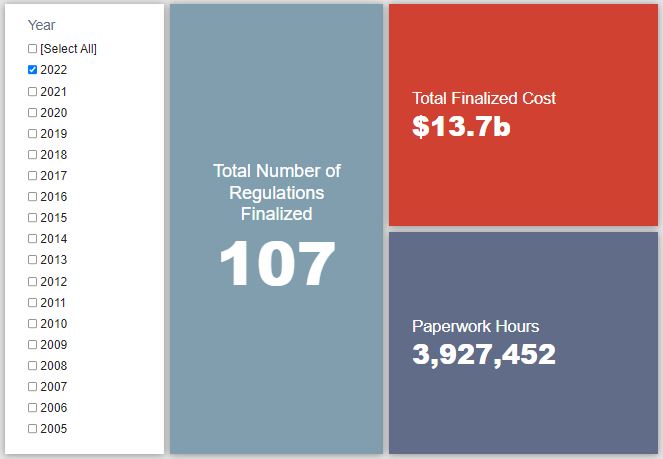Week in Regulation
June 6, 2022
Another Energy Efficiency Rule Pops Up
Last week, there were 10 rulemakings with some measurable economic impact. Nine of those, taken together, amounted to only $114 million in new costs. One rule, however, pushed that weekly haul into the billion-dollar range. Perhaps unsurprisingly – if one has been following the past handful of these weekly updates – it is yet another energy efficiency rule. Across all rulemakings, agencies published $2.5 billion in total net costs and added 46,460 annual paperwork burden hours.
REGULATORY TOPLINES
- Proposed Rules: 40
- Final Rules: 62
- 2022 Total Pages: 34,016
- 2022 Final Rule Costs: $13.7 billion
- 2022 Proposed Rule Costs: $75.1 billion
NOTABLE REGULATORY ACTIONS
The most significant action of the week was the Department of Energy (DOE) rule regarding “Energy Conservation Program: Energy Conservation Standards for Manufactured Housing.” As the title may imply, the rule seeks “to establish energy conservation standards for manufactured housing pursuant to the Energy Independence and Security Act of 2007.” DOE estimates that total “Consumer Incremental Product Costs” for the covered housing units add up to $2.4 billion. This rule comes just weeks after President Biden announced plans to address housing affordability – including, in particular, manufactured housing units.
Reading through the rulemaking’s background section, one does find an interesting case study that helps inform why there has been a recent flow of energy efficiency rules. The general story goes something like this: DOE proposes a new standard at the end of the Obama Administration; that standard is either actively or passively put on hold under the Trump Administration; the Biden Administration picks it back up due to renewed agency interest and/or judicial rulings in the interim years. This dynamic is hardly unique to DOE, but given certain statutorily driven deadlines in this regulatory space, these rulemakings appear to be coming back online at a swifter pace.
TRACKING THE ADMINISTRATIONS
As we have already seen from executive orders and memos, the Biden Administration will surely provide plenty of contrasts with the Trump Administration on the regulatory front. And while there is a general expectation that the current administration will seek to broadly restore Obama-esque regulatory actions, there will also be areas where it charts its own course. Since the AAF RegRodeo data extend back to 2005, it is possible to provide weekly updates on how the top-level trends of President Biden’s regulatory record track with those of his two most recent predecessors. The following table provides the cumulative totals of final rules containing some quantified economic impact from each administration through this point in their respective terms.
![]()
The DOE manufactured housing rule provided essentially the entirety of the Biden Administration’s $2.4 billion final rule cost total increase. Across the other two administrations, there was negligible movement from the Trump Administration, but there was some action on the Obama side. Costs in that period increased by nearly $6.6 billion while annual paperwork went up by almost 340,000 hours. A rule on air traffic control radar systems brought the bulk of the cost increase and a rule on Medicaid premiums and cost sharing contributed most of the new paperwork.
THIS WEEK’S REGULATORY PICTURE
This week, the Federal Aviation Administration (FAA) limits Boeing’s ability to self-regulate.

Source: “boeing 787 first flight” by Dave Sizer
On May 31, several news outlets reported that the FAA had granted Boeing’s request to extend its “Organization Designation Authorization” (ODA) in a limited manner. While Boeing requested a traditional five-year extension, the FAA granted just a three-year extension.
ODA is a program that allows the FAA to give private organizations the ability to act as a representative of the FAA administrator in certain capacities. The program essentially allows companies to certify their own work as compliant with regulatory requirements.
According to the FAA’s website, the ODA program “allows the FAA to leverage its limited resources through delegation.” The agency “may delegate to a qualified private person a matter related to issuing certificates, or related to the examination, testing, and inspection necessary to issue a certificate on behalf of the FAA Administrator as authorized by statute.”
The ODA program, and Boeing’s exercise of its delegated authority, came under scrutiny in 2019 following two crashes of Boeing 737-MAX aircraft that led the FAA to ground the entire fleet. As part of an omnibus spending measure at the end of 2020, Congress passed changes to the ODA program that limited the amount of authority the FAA can grant designees, along with other more stringent requirements.
According to the news reports, in a letter from the FAA to Boeing the agency said it was only granting a three-year extension of the company’s ODA in order to assess Boeing’s progress in making some of the legislatively mandated changes to the program.
TOTAL BURDENS
Since January 1, the federal government has published $88.8 billion in total net costs (with $13.7 billion in new costs from finalized rules) and 49.9 million hours of net annual paperwork burden increases (with 3.9 million hours in increases from final rules).












